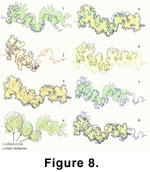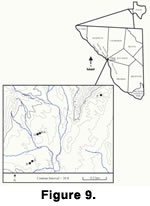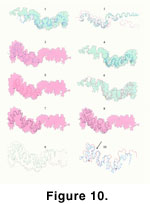 Templates
Templates Templates
TemplatesTo visualize the difference between the left and right sutural templates, the right Coilopoceras springeri template was overlaid on the Coilopoceras springeri right/left template. Figure 5.1 reveals the differences between right and left sutures. Notice that the horizontal sutural template length is much shorter for the right template.
The Hoplitoides sandovalensis and Coilopoceras springeri right templates were compared (Figure 5.2). Even with as few as three suture patterns combined to make the template, one can easily see that the templates are different. The Hoplitoides sandovalensis template has taller lateral saddles than the Coilopoceras springeri template, and the ventral most element of the Hoplitoides sandovalensis template is much narrower than the Coilopoceras springeri template.
 Individual Sutures
Individual SuturesThe area of mismatch or difference between individual sutures is documented in Table 2. The units are arbitrary quantitative units, but allow accurate comparisons of the sutures scaled to the same grid. The same Hoplitoides sandovalensis suture pattern drawn by two different authors shows a difference of 6.62 units (Figure 6.1). This difference demonstrates minimal error in tracing suture patterns. The area of mismatch or difference between the right and left opposing sutures of Coilopoceras springeri holotype is 10.48 units (Figure 6.2, Table 2). The closest sutural match of a second specimen to the Coilopoceras springeri holotype right suture is the Coilopoceras springeri paratype USNM 420161. Figure 6.3 shows the comparison of these two specimens. The difference in area between them is 14.45 units, indicating that the difference between individuals is larger than the difference between the right and left sides of the same individual (Table 2). In Figure 6.4, the Coilopoceras springeri USNM 420159 and Coilopoceras colleti USNM 278092 sutures have been compared to each other. The area of mismatch between these two different species is 21.87 units, which indicates that the difference between two different species is larger than the difference within the same species, as noted in Table 2. Coilopoceras springeri USNM 275907 and Hoplitoides sandovalensis USNM 420145 suture patterns (Figure 6.5) were also compared to each other. The area of mismatch between these two genera, as shown in Table 2, is 32.08 units, indicating that the largest area of difference is seen between genera.
 Several USNM specimens identified as Coilopoceras springeri were tested against the
Coilopoceras springeri right/left template. First, consider USNM 278120, a rather unusual suture pattern compared with the other
Coilopoceras springeri suture patterns, in that the first element in the lateral saddle seems too deeply split. The elements of USNM 278120 do not exactly line up with the template's elements
(Figure 7.1) though the suture pattern mostly fits within the template. To get a better idea of just how much area is out of the template, the suture pattern of USNM 278120 was overlaid with the Coilopoceras springeri
right/left template. As can be seen in
Figure 7.2, little suture pattern lies outside of the polygon. The percentage of suture pattern length that does not fit within the template was also calculated. The percent of suture that falls outside of the sutural template is 4.85%, as seen in
Table 3.
Several USNM specimens identified as Coilopoceras springeri were tested against the
Coilopoceras springeri right/left template. First, consider USNM 278120, a rather unusual suture pattern compared with the other
Coilopoceras springeri suture patterns, in that the first element in the lateral saddle seems too deeply split. The elements of USNM 278120 do not exactly line up with the template's elements
(Figure 7.1) though the suture pattern mostly fits within the template. To get a better idea of just how much area is out of the template, the suture pattern of USNM 278120 was overlaid with the Coilopoceras springeri
right/left template. As can be seen in
Figure 7.2, little suture pattern lies outside of the polygon. The percentage of suture pattern length that does not fit within the template was also calculated. The percent of suture that falls outside of the sutural template is 4.85%, as seen in
Table 3.
On the other hand, the specimen Coilopoceras springeri USNM 278121 falls satisfactorily in the Coilopoceras springeri left template (Figure 7.3). The elements all line up nicely, the exception being the second element from the venter, which is slightly taller than that of the template. The percentage of suture length that falls outside the boundaries of the left Coilopoceras springeri template is 17.48% (Table 3).
Hoplitoides sandovalensis is the ancestor of Coilopoceras springeri. The shell shape of Hoplitoides sandovalensis is virtually identical to Coilopoceras springeri, as Cobban and Hook (1980) pointed out. Hoplitoides sandovalensis USNM 275883 was tested against the Coilopoceras springeri left template. The Hoplitoides sandovalensis lateral saddle is significantly taller than the Coilopoceras springeri left template (Figure 7.4). Another interesting observation is that the lateral lobe element closest to the umbilicus is very deep. Hence, there is a large angle from the lateral saddle element closest to the venter to the lateral lobe element closest to the umbilicus. The percentage of Hoplitoides sandovalensis suture length outside of the Coilopoceras springeri left template is 47.24% (Table 3).
Two different sutures taken from the same specimen of Hoplitoides sandovalensis, USNM 420145, were tested against the Coilopoceras springeri right template (Figure 7.5-7.6). The specimen is described as a juvenile, and the two sutures were copied from sutural drawings taken from Cobban and Hook (1980). Like the previous Hoplitoides sandovalensis specimen, the first element (closest to the venter) is taller than the Coilopoceras springeri template. This specimen, however, does not seem to have the large angle from the saddle closest to the venter to the lobe closest to the umbilical sutures. The suture pattern in Figure 7.5 is denoted Hoplitoides sandovalensis USNM 420145 pattern 2. The percentage of suture length that falls outside of the boundary of the Coilopoceras springeri right template is 20.58% (Table 3). The other suture pattern from the same specimen is shown in Figure 7.6 and labeled Hoplitoides sandovalensis USNM 420145 pattern 3. The first element (closest to the venter) is taller on the Hoplitoides sandovalensis suture than the Coilopoceras springeri template. The percent of suture length outside of the Coilopoceras springeri right template is 26.37% (Table 3).
 Coilopoceras inflatum USNM 275937 was placed within the
Coilopoceras colleti right template to compare the differences and similarities between these two species
(Figure 8.1). The Coilopoceras inflatum sutural elements are similar to the
Coilopoceras colleti right template elements. However, in the first element closest to the
venter, the Coilopoceras inflatum suture is placed more ventrally. The percentage of suture length that falls outside of the
Coilopoceras colleti right template is 22.35%. The calculated figure is listed in
Table 3.
Coilopoceras inflatum USNM 275937 was placed within the
Coilopoceras colleti right template to compare the differences and similarities between these two species
(Figure 8.1). The Coilopoceras inflatum sutural elements are similar to the
Coilopoceras colleti right template elements. However, in the first element closest to the
venter, the Coilopoceras inflatum suture is placed more ventrally. The percentage of suture length that falls outside of the
Coilopoceras colleti right template is 22.35%. The calculated figure is listed in
Table 3.
Suture patterns taken from various other museum specimens were tested using the Coilopoceras springeri, Hoplitoides sandovalensis, and the Coilopoceras colleti templates. Hoplitoides wohltmanni USNM 307655 was tested against all three templates. Hoplitoides wohltmanni is the ancestor of Hoplitoides sandovalensis (Cobban and Hook (1980)), which was tested in the Hoplitoides sandovalensis right template (Figure 8.2). The elements possess a similar alignment of sutural elements. The difference is that the Hoplitoides wohltmanni sutural elements are shorter than the Hoplitoides sandovalensis template elements, and the percentage of suture length that falls outside of the template is 38.50% (Table 3). When Hoplitoides wohltmanni USNM 307655 was placed into the Coilopoceras springeri right template (Figure 8.3), an even closer fit was noticed with 5.65% falling outside the template (Table 3). The only difference is in the lateral saddle closest to the venter, where it crosses the Coilopoceras springeri template slightly. Looking at the same specimen in the Coilopoceras colleti right template (Figure 8.4), several differences are clear. The basic shape of the pattern fits; however, the Coilopoceras colleti right template has only three lateral elements whereas Hoplitoides wohltmanni exhibits four lateral elements, similar to Coilopoceras springeri and Hoplitoides sandovalensis. The percentage of suture length that falls out of the sutural boundary is 22.75% (Table 3).
Coilopoceras colleti USNM 278093 is one of the sutures used in making the Coilopoceras colleti right template. This suture shows many differences from the Coilopoceras springeri right template (Figure 8.5). A primary difference is in the number of lateral sutural elements, with Coilopoceras colleti exhibiting only three lateral elements while the Coilopoceras springeri right template shows four lateral elements. There is 11.32% of the suture length outside of the template (Table 3).
Another Coilopoceras colleti of interest was specimen USNM 275894. Tested against the Coilopoceras springeri right/left template (Figure 8.6), a few differences were noted. As with the previous Coilopoceras colleti, the suture pattern for this specimen exhibits only three elements. There also is an obvious height difference, as Coilopoceras colleti USNM 275894 is much taller than the Coilopoceras springeri template. Table 3 shows that 26.35% of the Coilopoceras colleti suture length falls out of the Coilopoceras springeri right/left template.
Coilopoceras inflatum is the youngest of the Coilopoceras species
(Cobban and Hook 1980). Coilopoceras inflatum USNM 275939 was tested against the
Coilopoceras colleti, Coilopoceras springeri, and Hoplitoides sandovalensis templates. Both
Coilopoceras inflatum and Coilopoceras colleti have only three elements in the lateral suture. The
Coilopoceras inflatum suture resembles the Coilopoceras colleti right
template (Figure 8.7). The elements are aligned but the Coilopoceras inflatum suture is taller in the first element and much deeper in the lobes. The percentage of
Coilopoceras inflatum suture length that falls outside of the Coilopoceras colleti
right template is 43.45%
(Table 3). The Coilopoceras inflatum USNM 275939 suture was then tested against the
Coilopoceras springeri right template (Figure
8.8), showing that 31.42% of the suture length fell outside of the Coilopoceras springeri
right template (Table 3). The Coilopoceras inflatum suture proved to be much taller in the lateral most saddle element and has three lateral sutural elements versus the four lateral sutural elements in the
Coilopoceras springeri right template. Tested against the Hoplitoides sandovalensis
right template,
Coilopoceras inflatum USNM 275939 showed a difference in element count, three
(inflatum) versus four (sandovalensis). Table
3 shows that 47.92% of the suture length is outside of the Hoplitoides sandovalensis
right template. The best visual fit of
Coilopoceras inflatum USNM 275939 out of the three templates is with the
Coilopoceras colleti right template.
Table
3 shows that 47.92% of the suture length is outside of the Hoplitoides sandovalensis
right template. The best visual fit of
Coilopoceras inflatum USNM 275939 out of the three templates is with the
Coilopoceras colleti right template.
Ammonite specimens were collected approximately 3 km from the Chispa Summit type locality (Figure 9). The landowners requested contact through the author or to see reposited specimens for specific locations. Representatives from each sample location were chosen to test against the sutural templates. Eight specimens were selected.
The specimen from measured section B, TMM NPL 1848, was found as float within unit B7. The partial specimen was in three pieces and exhibited suture patterns that were easily traceable. TMM NPL 1848-A (left suture) was tested against the Coilopoceras springeri left template (Figure 10.1). The suture pattern of TMM NPL 1848-A fits nicely within the Coilopoceras springeri left template, with the only real difference being that the second element is slightly taller than the model. The percent of suture outside of the template is 18.03%. The right suture of the same specimen, coded as TMM NPL 1848-AA, was tested against the Coilopoceras springeri holotype right suture (Figure 10.2). Note that the elements are mostly aligned, with the unknown specimen taller for the first three elements, although the fourth element is not aligned. The percentage of suture length that fell outside of the Coilopoceras springeri right/left template was 8.07% (Table 3). TMM NPL 1848 is clearly a Coilopoceras springeri.
 TMM NPL 1849 was collected from measured section E (Figure
9). The unknown suture was taken from TMM NPL 1849 and tested in the Coilopoceras springeri
right/left template and fits within the template
(Figure 10.3). The percentage of suture length that falls outside of the template is 1.04%. Clearly, this specimen is a
Coilopoceras springeri.
TMM NPL 1849 was collected from measured section E (Figure
9). The unknown suture was taken from TMM NPL 1849 and tested in the Coilopoceras springeri
right/left template and fits within the template
(Figure 10.3). The percentage of suture length that falls outside of the template is 1.04%. Clearly, this specimen is a
Coilopoceras springeri.
Another specimen from measured section E is TMM NPL 1850. The specimen is a very large ammonite consisting of four pieces. TMM NPL 1850-A was tested within the Coilopoceras springeri left template (Figure 10.4). The suture pattern of TMM NPL 1850-A fits 85% (Table 3) within the Coilopoceras springeri left template; again, this specimen is a Coilopoceras springeri.
The representative from measured section H (Figure 9) was badly weathered but sutures could be copied from each side of the ammonite. TMM NPL 1851 sutures were tested, respectively, in the Coilopoceras springeri right/left template and the Coilopoceras springeri left template. They fit within their particular models (Figure 10.5-10.6), and the percentage of suture length that falls outside of the templates is small (Table 3). This specimen is also clearly a Coilopoceras springeri.
Specimen TMM NPL 1852 was found at the mouth of a wash in Location KK (Figure 9). Field observation, based on the suture pattern, placed this specimen outside of Coilopoceras springeri. Suture TMM NPL 1852 was tested within the Coilopoceras springeri right/left template (Figure 10.7). The suture pattern fits mostly within the boundaries of the polygon; only 2.26% is outside of the template. When visually assessing this suture pattern in the field, only three lateral elements were noted. After placing a suture from TMM NPL 1852 in the Coilopoceras springeri right/left template, it becomes evident that the first and second lateral sutural elements are not completely split like most Coilopoceras springeri. However, the suture fits within the boundary of the template, and all the sutural elements are aligned with the template's elements, hence, this specimen can be identified as Coilopoceras springeri.
Specimens TMM NPL 1853 and TMM NPL 1854 were collected from measured section P (Figure 9). Specimen TMM NPL 1853 suture pattern was tested within the Coilopoceras springeri right/left template (Figure 10.8). The suture pattern fits relatively well within the template, and only 8.57% of the suture length is outside of the template (Table 3). The second, third, and fourth lateral sutural elements of TMM NPL 1853 are slightly offset toward the venter from the Coilopoceras springeri right/left template elements. TMM NPL 1854 was also tested within the Coilopoceras springeri right/left template (Figure 10.9). Like the other specimen from section P, the suture fits mostly within the boundaries of the template, with only 3.59% of its length being outside of the template (Table 3). The second and third lateral sutural elements of TMM NPL 1854 are slightly offset toward the venter from the Coilopoceras springeri right/left template elements. These two specimens are clearly Coilopoceras springeri, even though the elements of both are slightly offset from the templates. One possible explanation for the offset is that the large ribs on these specimens from this location forced a shift in septal position.
A specimen (TMM NPL 1855) from 20 miles northwest of the field location was examined. The unusual split in the lateral element closest to the venter and the shell's sharp keel resemble those in the Coilopoceras springeri specimen USNM 278120 (Figure 7.1). A suture taken from TMM NPL 1855 was tested against the suture pattern of Coilopoceras springeri USNM 278120 (Figure 10.10). Compared to USNM 278120, TMM NPL 1855 has basically the same alignment, and the match between the unusual split is nearly identical. The percentage of suture length that falls outside of the Coilopoceras springeri right/left template is 11.18% (Table 3). TMM NPL 1855 is visibly the same species as USNM 278120, a Coilopoceras springeri.